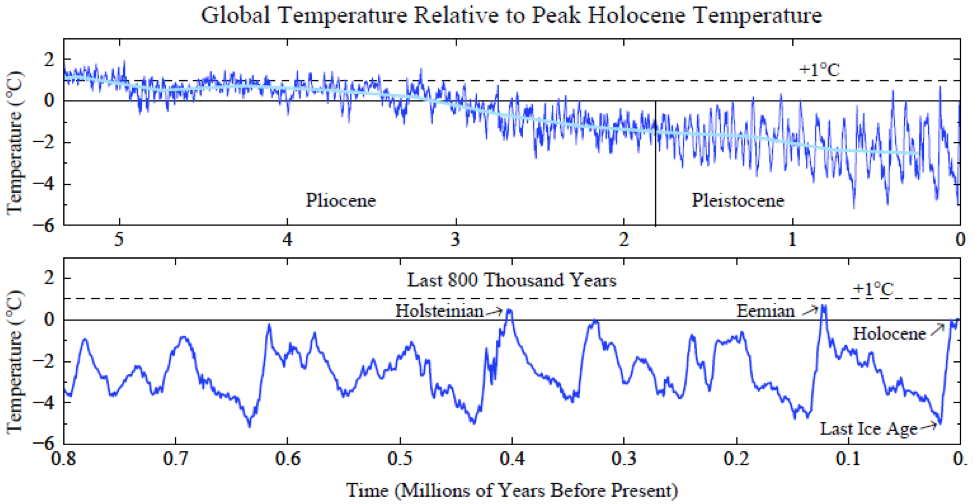The concerning implication is that further warming by 1 degree or less over coming decades could trigger a rise in sea level of 5 metres or more, similar to levels during the earlier interglacial periods. This is much more than the 18-60 cm rise projected in 2007 by the Inter-Governmental Panel on Climate Change (IPCC) using earlier data, and puts us on the brink of “dangerous” warming right now.
The urgency of Hansen and Sato’s message is bolstered by records from 3-5 million years ago (during the Pliocene epoch, see graph below) which show temperatures no more than one degree warmer than now but sea levels as much as 25 metres higher than now, a rise that would be catastrophic.

Advertisement
Hansen and Sato also argue that ice sheet melting and breakup is an exponentially accelerating process that doubles its speed every 6-10 years, rather than a steady process. This implies that sea level rise would be much faster than previously thought. An accelerating process is expected because melt water tends to lubricate the bases of glaciers, which flow and break up more quickly, and because substantial parts of the West Antarctic ice sheet are grounded below sea level, so ocean warming and ice thinning can float their edges away more readily.
Melt rates, ice mass losses and sea level rise have all been measured to be increasing, consistent with these arguments. However the data do not yet extend for a long enough period to confirm that an exponential doubling process is occurring, and to accurately estimate the doubling time. The data are consistent with a doubling time of 6-10 years, and this will become more accurately known over the next 5-10 years. Even a doubling time of 10 years allows nine doublings this century, so rates could increase 500 times, to metres per year by 2100.
Hansen first advanced arguments along these lines in 2007, but the new paper brings more data and insights to bear, and moves the conclusions from conjectural to plausible. There are of course many who deny that global warming is caused by human activity. Most such claims are based on only small portions of the wide range of arguments mentioned earlier. The Hansen and Sato conclusions do not require computer models of climate, and they are quite independent of the “climategate” controversy, which in any case was an enormous beatup of some private discussion of quite peripheral data sets. It is past time that policy makers gave serious attention to those whose long and successful careers, under the scrutiny of rivals, attest to the breadth and depth of their understanding.
A sea level rise of several metres would devastate global civilisation, as large populations, many cities and much infrastructure are within only a few metres of sea level. After the extreme weather of Black Saturday, Australia added the “Catastrophic” category of bush fire danger above the previous highest “Extreme” category.
The danger from global warming may have moved from “Extreme” to “Catastrophic”.
Discuss in our Forums
See what other readers are saying about this article!
Click here to read & post comments.
41 posts so far.